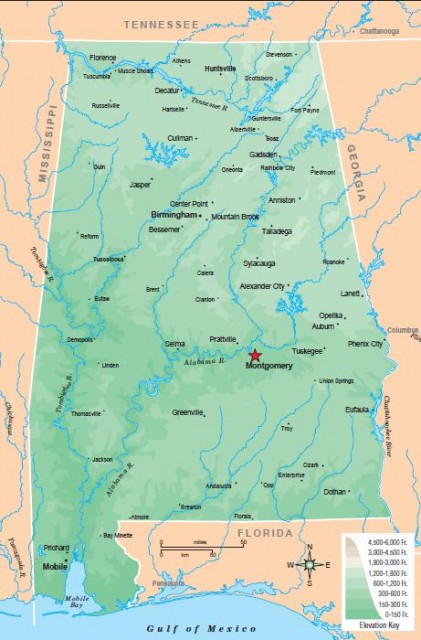The State of Alabama
AT A GLANCE
Name: Alabama comes from the word Alibamu, the name of a Native American tribe that lived in the area. The name may mean “to clear the vegetation.”
Nicknames: Heart of Dixie, Camellia State, Yellowhammer State
Capital: Montgomery
Size: 52,237 sq. mi.
Population: 4,849,000 (2014)
Statehood: Alabama became the 22nd state on December 14, 1819.
Electoral votes: 9 (2016)
U.S. Representatives: 7 (until 2016)
State tree: Southern longleaf pine
State flower: camellia
State saltwater fish: fighting tarpon
Highest point: Cheaha Mountain, 2,407 ft.

THE PLACE
Alabama is located in the heart of the Deep South. The Appalachian Mountains end in the northern part of the state, which is covered by forested hills. In the south, these hills become smaller and give way to rich grasslands. Alabama's coast on the Gulf of Mexico has both sandy beaches and bayous, which are swampy streams.
Although the state's warm climate is ideal for farming, Alabama was one of the first southern states to become industrialized.
THE PAST
Alabama's history stretches back at least 8,000 or 9,000 years, to the time when cliff-dwelling Native Americans inhabited Russell Cave, near Bridgeport.
The first Europeans to reach Alabama were the Spanish, who are believed to have sailed into Mobile Bay in 1519. Hernando de Soto explored inland portions of the state in 1540. Later, the French built the first permanent European settlement in Alabama, at Fort Louis de la Louisiane, in 1702. In 1763, the British took control of the area through the Treaty of Paris.
When the United States gained its independence in 1783, Britain was forced to give up the colony. Most of the area became part of the new American nation, except for the Mobile Bay area, which was under Spanish rule. In 1813, the United States gained control of the Mobile region, and in 1819, Alabama became the 22nd state.
Alabama rose to importance during the American Civil War. Montgomery was declared the capital of the Confederate States of America, which was the new union formed by the Southern states. (The Confederate capital was later moved to Richmond, Virginia.)
Before and after the Civil War, Alabama's economy depended primarily on the cotton industry. In 1915, however, the boll weevil, which infests cotton plants, began to destroy crops. Farmers were forced to find other ways to make a living. Some began to raise livestock and grow crops besides cotton. Others turned to industry and built factories that manufactured a number of products, including steel.
Alabama again became the focus of American attention during the 1950s when Rosa Parks, an African American woman, refused to give up her bus seat to a white male passenger. Her action set off the civil rights movement, which eventually gave African Americans equal legal rights in the United States.
Many Americans in Alabama and throughout the country fought to keep the South racially divided. On September 15, 1963, a bomb exploded in the Sixteenth Street Baptist Church in Birmingham, which had been a local center for the civil rights movement in Alabama. The bomb killed four young girls. In 1965, Martin Luther King Jr., the most famous American civil rights leader, led a march from Selma to Montgomery to protest segregation (legal divisions between African Americans and whites).
Born in Alabama
- Hank Aaron, baseball player
- Nat “King” Cole, musician/entertainer
- W.C. (William Christopher) Handy, blues songwriter
- Mae Jemison, astronaut
- Helen Keller, author/educator
- Coretta Scott King, civil rights activist
- Harper Lee, author
- Jesse Owens, track star
- Rosa Parks, civil rights activist
- Condoleeza Rice, professor, diplomat, national security adviser
THE PRESENT
Service is the largest industry in Alabama. Farming is still important, however, and Alabama continues to grow crops, including cotton and peanuts. Manufacturing also contributes to the state's economy.
Innovative rockets and space technology are produced in Huntsville, which is known as Rocket City, USA. The city is home to the Redstone Arsenal and the George C. Marshall Space Flight Center, where scientists built the Saturn 5 rocket that took the first astronauts to the moon.
Many people visit Alabama to experience its history and enjoy its sandy beaches along the coast. Every year, visitors interested in history come to see the former Confederate capital and tour the area's many pre–Civil War homes.
Other places of historic interest include Helen Keller's childhood home and Russell Cave. There are also picturesque state parks throughout Alabama. In northern areas, reservoirs attract thousands of fishing enthusiasts each year. Because of Alabama's French past, its annual Mardi Gras celebration is also one of the state's most interesting and popular events.
Facts and Firsts
- In 1886, Montgomery became the first U.S. city to use electric streetcars for transportation. Montgomery is known as the Pittsburgh of the South because of its steel production, factories, and railroad yards.
- The Berman Museum in Anniston has a collection of about 1,500 weapons that once belonged to such famous figures as Napoleon I and Jefferson Davis, president of the Confederacy.
- George Washington Carver, a scientist who did a great deal of research in Alabama, discovered more than 300 uses for peanuts and more than 100 uses for sweet potatoes.